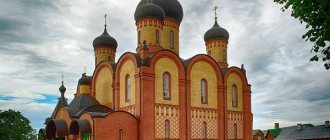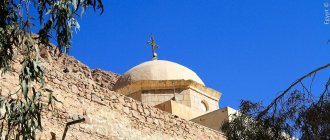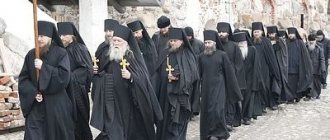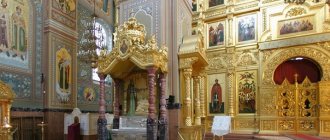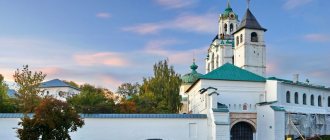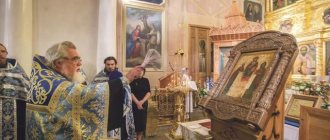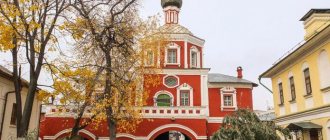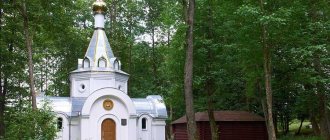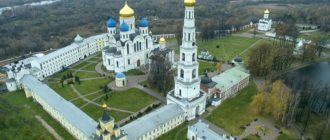The Russian Orthodox Church tries to keep up with the development of technology and be closer to people, therefore the Tikhvin Monastery, located in Tikhvin, has its own official website, which contains all the information necessary for potential visitors. However, we want to tell you more about this Orthodox monastery.
The Assumption Tikhvin Monastery is an Orthodox male monastery, a holy monastery, to the walls of which dozens of pilgrims traveling to the holy places of our Motherland come annually, people who want to renounce worldly life and devote themselves to serving God and prayer, as well as simply tourists who are admired by the very appearance , the history of a holy place and a miraculous icon.
The “sister” of the Assumption Monastery is considered to be the Vvedensky Convent, which was founded simultaneously with it, according to the royal decree of February 11, 1560.
Description and location
Tikhvin Mother of God Assumption Monastery - this is its full name, as is already known, is intended for men. It was created by Archbishop Pimen of Novgorod in 1560, as indicated to him by Tsar Ivan the Terrible.
Please note: the main shrine located within the walls of the monastery is called the Tikhvin Icon of the Mother of God Hodegetria. It is precisely to pray to her that pilgrims come here.
Here are the Assumption Cathedral, the Church of the Intercession, the Church of the Tikhvin Icon of the Mother of God “Porch”, a belfry and cell buildings in which the monks live. The rector is hegumen and holy archimandrite Mstislav.
The location of the monastery is the Leningrad region, in the picturesque town of Tikhvin, so named because it stands on the Tikhvinka River.
We are sure that you will also be interested in the article about the St. Barsanuphius Monastery in Intercession Selishchi.
Patronal holidays[edit]
- Icon of the Blessed Virgin Mary “Tikhvin”
- July 9 - Assumption of the Blessed Virgin Mary
- August 28 - Intercession of the Blessed Virgin Mary
- October 14 - Ascension of the Lord
- 40th day after Easter - Peter and Paul, chief apostles
- July 12 - Exaltation of the Life-Giving Cross of the Lord
- September 27 - Theodore Stratelates, Great Martyr
– February 21, June 21
History of the monastery
The history of the community dates back 457 years from the date of its foundation by decree of Ivan the Terrible on February 11, 1560. The main shrine of the monastery was the icon of the Tikhvin Mother of God, the intercessor and guide of the Russian land. The Lavra is not only a shrine for all Orthodox people and a source of spiritual strength for the entire Russian people. Once served as a defensive line of defense against invaders.
The Tikhvin monastery, located in the north-west of Rus', also served as a lookout point during the Livonian War, which was led by Ivan the Terrible. The Swedes also besieged the fortress in 1613, however, thanks to the bravery of those who defended it, they were never able to take the impregnable walls. The monastery also survived the terrible times of the Troubles at the beginning of the 17th century.
The 20th century was especially difficult for the community. When the revolution occurred, the Bolsheviks plundered the monastery, took away all the valuables, and closed the monastery. During the Great Patriotic War, it became an arena where the Red Army fought a fierce battle with the German invaders.
In 1945, the Church of the Tikhvin Mother of God “Krylechko” was transferred for worship to the Russian Orthodox community. This temple became the only functioning church in the territory of two districts: Tikhvin and Boksitogorsk. And in 1995, the monastery was transferred to the full ownership of the Russian Orthodox Church, and the Assumption Cathedral was restored.
Tikhvin Dormition Monastery of the Mother of God - a shrine of Russia
The mysterious history of the Tikhvin Mother of God Assumption Monastery
In the Leningrad region there are many amazing places that are worthy of special spiritual attention, to which, due to a reverent attitude towards them or spiritual delight, people are drawn.
This article is a short story about one of these “corners of the Russian soul” - the Tikhvin Assumption Monastery of the Mother of God, located in the city of Tikhvin, and its Miracle-Working Icon, a shrine of world Orthodoxy.
With its appearance in Russia, the icon confirmed the special status of the power “in the face of God” and became a vivid historical symbol of the emerging Russian centralized state.
The history of the Tikhvin Dormition Monastery of the Mother of God is very interesting and surprising. It arose, according to the Novgorod Chronicle, on the site of the appearance in 1383 of the icon of the Most Holy Theotokos - the Miraculous Icon of the Mother of God Hodegetria. Her name, translated from Greek, means “guide”, “showing the way”.
According to legend, the image was painted by the Holy Apostle Evangelist Luke during the earthly life of the Virgin Mary. The icon was sent along with the text of the Gospel and the Acts of the Holy Apostles as a gift to Theophilus, the ruler of Antioch.
In the 5th century in Constantinople, the Blachernae Church (reliquary) was built for the icon - a repository of the main shrines of Byzantium. As you know, it was the first Christian empire.
In 1383, according to the Novgorod Chronicle, “this icon of Hodegetria was taken from Constantinople by the mania of God and transferred to Rus'.” The image of the Mother of God miraculously, through the air, disappeared from Constantinople and appeared to fishermen over Lake Ladoga, near the ancient capital of Rus' - Staraya Ladoga, in Tikhvin.
The Patriarch of Constantinople, having listened to the testimonies of Novgorod merchants and their descriptions of the image, confirmed that the icon revealed in Rus' is the same one that left Byzantium irrevocably “for pride, brotherly hatred and the lies of the people.” 70 years later, Constantinople fell.
The icon moved to Tikhvin land shortly after the victory over the hordes of Mamai by the united Russian troops under the command of the blessed prince Dmitry Donskoy.
Local residents and fishermen saw the icon floating across the sky and watched its movement for a long time, until the icon was lowered by the angels carrying it on one of the banks of the Tikhvinka River. The angels were not visible due to the light emanating from the icon.
On the same day, in the place where the icon ended up, the residents urgently, by common decision, began to erect crowns for the future church and prepared logs. We only managed to make the three lower crowns, since it was already dark and we had to take a break. After praying, the builders dispersed, leaving a guard for the night.
At night the guards fell asleep, and in the morning neither the icon nor the logs were in place. People rushed to search and were faced with a situation that was incredible to understand - the icon, the crowns, and even all the chips ended up on the opposite bank of the river. Residents decided that the icon chose its own place. A wooden church was built there. It was a wooden church in honor of the Dormition of the Virgin Mary.
On the holy icon, the Mother of God is depicted at half height, with a crown on her head. On her left hand sits the Infant God, blessing with his right hand, and holding a scroll in his left. The holy icon is richly decorated. Every year thousands of people flocked to the city of Tikhvin to venerate the holy miraculous icon.
Over the years, the wooden church burned several times, it was restored again and again, until in 1510 a stone church was rebuilt in Tikhvin.
The meaning of the miraculous icon for royalty and all of Rus'
From time immemorial, Russian rulers treated the miraculous icon with great respect. Ivan the Terrible's father, Vasily III, prayed to her for an heir from his new wife, Elena Glinskaya, and 2 years after praying for childbearing, he was rewarded with a son, Ivan IV (the Terrible).
Vasily III was constantly accompanied by Archbishop Macarius, who was appointed to the Novgorod see. Subsequently, he arrived in Tikhvin with Ivan IV.
Ivan the Terrible treated the icon of the Tikhvin Mother of God with special trepidation and reverence. In 1547, he came to worship her 15 days before the crowning of the kingdom - to receive a blessing for the title of “king” (“Caesar”) from the shrine, revered as Roman and Constantinople. I also visited before my wedding with Anastasia.
Throughout his life, Ivan the Terrible considered the icon his patroness. When in 1552, during a campaign against Kazan in one of the Russian army’s overnight camps on the Pyana River, the icon of the Mother of God appeared to the Tsar in a dream and strengthened him “to overcome his enemies,” Ivan the Terrible took this as a divine sign.
Later, in 1560, by personal order of Ivan the Terrible, two monasteries were founded in Tikhvin - a men's (Big Uspensky) monastery on the left bank of the Tikhvinka River and a women's (Vvedensky, or Maly) monastery on the right bank.
The Assumption Cathedral was erected in 1510 - 1515 (before the appearance of the monastery) by decree and at the expense of the father of the legendary Ivan the Terrible, Grand Duke Vasily Ioannovich. The stone Assumption Cathedral was built specifically for the veneration of the icon. It became a kind of reliquary for the list, which was patronized by the Moscow Grand Duke's House. This predetermined such close attention to the distant Novgorod settlement throughout its history and turned Tikhvin into a famous place of pilgrimage.
The Assumption Cathedral in the Moscow Kremlin, the creation of Aristotle Fiorovanti (1479), was taken as an architectural model. The Assumption Cathedral was rebuilt and reconstructed many times and its appearance changed significantly.
In the second half of the 17th century, the Assumption Cathedral was painted by Rodion Sergeev, Pyotr Falileev, and Ivan Shemushsky. Some of their work has survived to this day on the outer walls of the cathedral. Above the arch of the holy gates, a fragment of the inscription has been preserved: “By the grace of Christ and the favor of our Most Holy Lady Theotokos and Ever-Virgin Mary and with that help, by the command of the Tsar and Grand Duke John Vasilyevich of All Russia, this monastery began and was established in the summer of February 7068 on the 11th day.”
The Assumption Monastery, located at that time on the northwestern border of Rus', became not only a spiritual and educational center, but also a military fortification. The military significance of the monastery manifested itself during the Livonian campaigns of Ivan the Terrible. The monastery carried out state patrol and communications services. During the aggravation of Russian-Swedish relations, it was not only the Tikhvin Monastery that was subjected to invasions of the “Luthor scourge.”
The monastery constantly attracted great attention from patrons and benefactors. Thus, Tsar Fyodor Ioannovich Romanov in 1584 donated a 300-pound polyeleos bell, which served to ring the gospel on polyeleos holidays. In 1630, the sovereign donated 3,000 sheets of white iron to cover the domes of the Assumption Church. In 1718, 67 “the best trading people of Tikhvin” made a votive offering to the miraculous image - a silver-gilded frame, decorated with pearls and gems.
During difficult times of war, the Assumption Monastery became one of the few fortifications that could withstand the Swedish troops. The fighting lasted from the end of May to September 15, 1613 and ended with the final expulsion of the Swedish troops.
The war seriously damaged the economy of the Tikhvin land. The natural course of agricultural work was disrupted, the suburbs were devastated. The monastery was able to fully recover only by the middle of the 17th century. Significant destruction was caused by a fire on June 29, 1623. Almost all wooden buildings burned down, and the explosion of the stone belfry, where military supplies and gunpowder were stored, damaged the walls and domes of the Assumption Cathedral.
Construction of the monastery continued. In 1669, at the expense of the Moscow clerk Bogdan Silin, the stone gate tower “Vvedensky Gate” was built.
In 1791, in the upper tier of the tower, a gate church was built in the name of the miraculous Tikhvin Icon of the Mother of God. The image of this icon is located on the western facade of the tower. There used to be an open wooden staircase leading up to it. After the healing of an ailing pilgrim (historical fact), who could hardly climb the stairs to the gateway icon, the worship of this icon increased.
It was decided to build a gate chapel that would protect the image from bad weather. In 1860-1865, according to the design of architect N.L. Benoit, it was replaced by the stone “Porch” chapel. Nowadays it is the winter church of the monastery.
Since the 18th century, an almshouse for the poor and crippled people operated at the Assumption Monastery. It existed until the closure of the Tikhvin Monastery.
The monastery was involved in many charitable foundations that provided support to the wounded and families of those killed in numerous military campaigns.
At the beginning of the 18th century, the whole country was plunged into the difficult trials of the Time of Troubles. Since 1919, actions to nationalize monastic values began to be carried out. In 1919, a transit prison was placed in the monastery.
In mid-1924, the monastery was closed and destroyed, like many other churches and monasteries, although services in the Assumption Cathedral continued until 1936.
In the early 1930s, the eastern and northern walls of the monastery were destroyed. They were blown up, deciding to disassemble them into bricks for building houses in the neighboring city of Boksitogorsk. But the walls fell apart into blocks, and it was impossible to separate the bricks from each other by any force, because these were walls that had withstood military sieges. The blocks were taken to the Tikhvin – Boksitogorsk road under construction.
Bereavement - forced wanderings of the icon of the Mother of God
During the Great Patriotic War, the entire Leningrad region became the site of fierce battles with the fascist invaders. Tikhvin found himself under occupation already in November 1941.
The Nazis stole all the ancient icons from the monastery. Among them was the Tikhvin Icon of the Mother of God. Then she came to occupied Pskov, then, in 1944, to Riga.
The Nazis, in the hope of receiving the support of the Orthodox, used it - they issued it for the duration of services in churches in the occupied territory. During the retreat, they did not have time to take away the Miraculous Image.
The icon was preserved and saved by the Riga priest John Garklavs. He took her to the USA from Riga - through Liepaja, Gdansk, Koblenz and Prague, through refugee camps.
Father John, being in Chicago (Illinois), for 63 years kept and protected the Miraculous Icon, a shrine of world Orthodoxy. In 2003, having previously visited the Tikhvin Monastery and convinced of its revival, he made the final decision - to return the image to the restored monastery.
At that time, in 1973, the restoration of the belfry was carried out, during which the hipped roof of the spans was restored, and the plastic and decor of the 16th century were returned to the facades. The state-owned cells adjacent to the belfry were restored - a two-story building built in 1668 and 1678 in two stages by Novgorod and Tikhvin masons.
In 1993, a male choir of singers “Svetilen” was created in the Tikhvin Dormition Monastery of the Mother of God. The organizer and creative inspirer of the group was the hieromonk of the Holy Don Starocherkassk Monastery. Subsequently, he was the rector of the Tikhvin Dormition Monastery of the Mother of God - Archimandrite Euthymius. The musical group included graduates and teachers of the Rostov State Conservatory. S. V. Rachmaninov, professional musicians of various specialties - vocalists, choir conductors, wind players, populists, pianists, composers. The singing choir has earned numerous titles of laureates of all-Russian and international competitions.
To this day, the individual singing style of the group is based on the classical academic school of choral singing. The choir's repertoire is not limited to sacred music, but includes a wide range of musical styles - folk music, works by Russian and foreign classics, musical compositions in the American Barbershop style and the best examples of Russian music.
Father John entrusted the great deed of returning the miraculous icon to Russia to his adopted son Sergius Garklavs, who also became a priest.
Returning the shrine to its homeland
Archpriest Sergius fulfilled John's will. He even settled in the Tikhvin Dormition Monastery. In gratitude for the return of the miraculous shrine to the Motherland, Russian President V.V. Putin invited Father Sergius to choose, at his own discretion, any plot of land. The choice fell on a place next to the Holy Lake (Dymsky) in the Anthony-Dymsky Monastery - near the village of Red Armored Car, 17 km from Tikhvin. A house was built there, where Father Sergius moves during the summer heat.
In April 1995, residents of the city of Tikhvin sent an open letter to Patriarch Alexy II of Moscow and All Rus' with a request to bless the opening of the Mother of God Dormition Monastery, a holy monastery. In the same year, the monastery was transferred to the church, the Assumption Cathedral was restored and consecrated.
In May 1995, the religious association “Tikhvin Mother of God Assumption Monastery” was registered. In the same year, the first inhabitants moved into the monastery, who, together with pilgrims, began to carry out restoration and construction work to restore the monastery.
The first monastic tonsure was performed in an already operating monastery. Later, holiday services resumed. In July 1997, the first bishop's service took place in the Assumption Cathedral of the monastery. The service was led by His Eminence Metropolitan of St. Petersburg and Ladoga Vladimir.
In the spring of 2003, a final agreement was reached on the return of the Tikhvin icon to its native monastery. The delivery route for the icon after the flight from America was also agreed upon: Riga, Moscow, St. Petersburg and, finally, Tikhvin.
A working group was created to organize the return of the icon:
Chairman - His Eminence Patriarch of Moscow and All Rus' Alexy II.
Composition of the group:
- His Eminence Metropolitan of St. Petersburg and Ladoga Vladimir
- Governor of the Leningrad Region Valery Pavlovich Serdyukov
- Head of the Main Directorate of the State Traffic Safety Inspectorate of the Ministry of Internal Affairs of Russia Viktor Nikolaevich Kiryanov
- Abbot of the Tikhvin Dormition Monastery of the Mother of God, Hegumen Evfimy (Shashorin)
- Secretary of the Metropolitan of St. Petersburg and Ladoga Priest Sergius Ivanovich Kukskevich
- Advisor to the General Director of the Russian State Reserves Agency Sergei Stanislavovich Drachev
- Secretary-referent of His Holiness Patriarch of Moscow and All Rus' Nikolai Ivanovich Derzhavin.
The miraculous Tikhvin Icon of the Mother of God returned to Russia on June 23, 2004. On the day of the church-wide celebration of the appearance of the image on July 9, 2004, in the Tikhvin Monastery, the solemn liturgy was served by Patriarch of Moscow and All Rus' Alexy II, co-served by the Primate of the Orthodox Church in America, Metropolitan Herman, and many clergy.
Tikhvin Dormition Monastery of the Mother of God today
As before, the Tikhvin Dormition Monastery of the Mother of God remains a sacred place of great importance not only for the culture of Russia, but also for the whole world. One of the greatest Orthodox relics, the Tikhvin Icon of the Mother of God, is kept here. It largely determined the important role that this famous monastery played for more than six centuries in the history of our country.
Nowadays, the newspaper “Svyatinya” is published in the Tikhvin Monastery. There is an icon-painting workshop here, and in the gold-embroidery workshop, unique items are created to decorate Orthodox worship. The gold embroidery workshop employs professional embroiderers who studied at St. Tikhon's Theological University and the Torzhkov Art and Embroidery School. When working, they, observing all the Canons of the Church, use handmade technologies of the 17th-19th centuries.
For a long time, priest Sergius (Remizov) worked among the brethren of the Tikhvin Dormition Monastery of the Mother of God. Father Sergius is an amazing and wonderful person, sincerely devoted to his great work of serving God, serving the miraculous image of the Mother of God and people who come to the temple in order to worthily and solemnly celebrate a joyful event, find peace of mind, ask for health, and confess their troubles.
Father Sergius, wherever he was and is currently in service, seems to radiate great kindness and attention, a bright desire to help everyone who is looking for love, happiness and fulfillment of hopes in this beautiful world. Any person who came and comes to him with words of gratitude for his work, his sensitivity and patience, he said: “It is God and Our Lady of Tikhvin who are helping you.” The monastery is famous for such servants to this day.
In 2015, the Assumption Cathedral of the Tikhvin Assumption Monastery of the Mother of God passed the 500-year mark of its service to Russia.
The flow of excursions and pilgrims to this monastery is constantly growing, which means that faith in the justice of human relationships in the possibility of fulfilling pure innermost thoughts and desires remains eternal like Life itself, which to this day is protected and protected from enemies by the great patron saint of Our Lady of Tikhvin...
Prayer to Our Lady of Tikhvin
We thank Thee, O Most Blessed and Most Pure, Most Blessed Virgin, Lady, Mother of Christ our God, for all Thy good deeds, which Thou hast shown to the human race, especially to us, the people of Russia named after Christ, about whom the most angelic tongue will be pleased with praise.
We thank You, as even now You have surprised Your ineffable mercy on us, Your unworthy servants, with the supernatural self-coming of Your Most Pure Icon, and with it You have enlightened the entire Russian country.
In the same way, we, sinners, worship with fear and joy, crying out to Thee, O Most Holy Virgin, Queen and Mother of God, save and have mercy on Thy people, and grant them victory over all their enemies, and save the reigning cities, and all Christian cities and countries , and deliver this holy temple from every slander of the enemy, and grant everything for the benefit of everyone, who now come with faith and pray to Your servant, and who worship Your Most Holy Image, for blessed are You with the Son and God born of You, now and ever and unto ages centuries. Amen.
History of the Tikhvin Icon
The Tikhvin Icon of the Mother of God Hodegetria came to us from Constantinople. According to an ancient legend, several years before the fall of this city, in 1383, this icon “evaporated” by the will of God and ended up in Rus', where the image of the Mother of God appeared to the fishermen, hovering over the surface of Lake Ladoga. It is important that the Patriarch of Constantinople, having heard the stories of the Novgorod merchants and looking at the sketches from the icon, confirmed that this icon is the icon that left Constantinople for the blood, strife and pride that reigned in it. The icon came to Tikhvin after Dmitry Donskoy defeated Mamai’s army.
It is worth noting: in 1941, having occupied the monastery, the Germans took out everything they could from it: all the remaining utensils, icons and images (among them was that same icon of the Mother of God).
With the rapid retreat of the Germans, the image was taken to Pskov, and from there sent to Riga, then to Libau, later to Yabluncy, and from there it ended up in the zone of American occupation of Germany. From there the image was taken by Bishop John to Chicago, in the United States of America. The bishop bequeathed to his son, Sergius, to return the icon to Russia as soon as prosperous times came in Russia.
This is important: in 2003, after negotiations, the main shrine of this place, the Icon of the Tikhvin Mother of God Hodegetria, finally returned to its homeland. Nowadays the icon in Russia exists in many lists, almost all of them are recognized as miraculous. The original icon was solemnly returned to the Assumption Tikhvin Monastery in 2004, and copies were found in many churches and chapels, for example, the Temple-Chapel of the Tikhvin Icon of the Mother of God in Kronstadt.
Shrines[edit]
- Tikhvin Icon of the Mother of God
The miraculous appearance of the icon on the banks of the Tikhvinka River dates back to 1383. For it, a wooden church of the Assumption of the Virgin Mary was built on the site of the appearance, which in 1515 was rebuilt into a stone one, around which the Tikhvin Monastery grew. After the revolution, the icon was in the Museum of Local Lore, in 1941 it was taken by the Germans to Pskov and transferred to the Pskov Spiritual Mission. She “retreated” along with the Germans, then stayed in Germany, and in 1950 she was taken to the Holy Trinity Cathedral in Chicago. Its guardians were Archbishop John (Garklavs) of Riga, and then his adopted son Archpriest Sergius Garklavs. In 2004, the icon was returned to the monastery.
- Icon of the Mother of God “Starorusskaya”
Temples and buildings
Within the walls of this ancient monastery there are a total of six different structures: two churches, a belfry, the monastery building itself, cells, a guest house, a fence with turrets. All of them bear the imprint of history on their walls, all of them have already withstood the onslaught of the enemy many times. These walls were not only a container for everything that is sacred to our people, a protection for our faith, but they were also a protection for our people. All the buildings themselves are unique and have special architectural value.
Assumption Cathedral
The Assumption Cathedral is the oldest building of the Tikhvin Lavra; it was created back in 1515. This is a five-domed cathedral, where services are mainly held, and it is in it that the very treasure is kept - the Tikhvin Icon of the Mother of God.
However, the temple itself, the central building of the architectural ensemble, can rightfully be called a landmark: the magnificent paintings of its vaults - frescoes created by the hands of Rodion Sergeev, Pyotr Falliev and Ivan Shemushsky, create the impression that it is always sunny in it. The magnificent decoration of the altar, many icons, all this pleases the eye.
Church of the Intercession
The Church of the Intercession is carved, light and elegant: it is two floors high, the base is a pillarless quarter, decorated with a pile of kokoshniks with a dome, and, instead of the old wedding, a dome was installed on the church.
Adjacent to the church is a single-pillar refectory . You look at her and your soul immediately becomes light and light. This is the second oldest building in the community, built in 1581. The temple is located south of the Tikhvin Assumption Cathedral, services are also held here, and there are also refectory chambers in which dinners have been held since ancient times. To the right of it is the belfry - another interesting attraction of this place.
Belfry
What kind of temple can there be without a belfry? The belfry of our monastery is located in the wall enclosing the territory of the community; it is three-tiered and stands under five tents, sparkling with bells and small viewing windows.
Please note: to get into the belfry, you must go through a wooden gallery located inside the wall.
Previously, there were warehouses of food and weapons inside it in case of a siege. Locals call it not a belfry, but a “clock ringer”, because the bells ring at a certain time. Every day, every holiday, ringing bell voices illuminate the area, scattering over the silence reigning around.
Church of the Tikhvin Icon of the Mother of God
The church was built into the West Gate Tower at the beginning of the 17th century and was built in 1791 under the care of the nun Tabitha. The cube of the carved turret is topped with a cut quarter with an onion dome on it.
This is interesting: the church received the affectionate addition “Porch”, because previously there was a porch with several steps leading to the icon of the Mother of God.
The small and cozy church, in which services were held even when the monastery was destroyed, became very popular with the people. The church has survived a lot: since the revolution it was closed until 1944, but then, at the request of parishioners, it was opened and never closed again.
Fence with towers
The monastery grounds are surrounded by a powerful fence on pillars with a passage along the wall. There are four round stone turrets topped with pointed spiers, these have small dormers inside the walls.
Initially, the temple fence was made of wooden logs, like the temple itself, and only at the beginning of the 19th century the entire monastery was completely clad in stone. Bell towers and both churches are built into the fortress.
Another feature of the fence is its two-span “Holy Gate”. Inside them there is the Church of the Ascension of the Lord and the chapel of Fyodor Stratelates. Above the gate are two holy images - the Tikhvin Mother of God and St. Nicholas.
Museum-cell of monk Arseny
There is another attraction on the territory of the monastery - the museum of the cell of Elder Arseny. It is located in the cell building where the elder lived. In April 1899, he entered a monastery as a novice. Arseny was tonsured a monk on November 8, 1904, and in 1913 he was elevated to the rank of hieromonk.
In 1924, even when the monastery was closed and plundered, he served in the Tikhvin regimental church. The elder, despite the arrival of a new, apostate government, did not renounce his faith and his convictions. Even the fear of death could not force him to do this. Hegumen Arseny was shot by the Bolsheviks in 1937. The monk was buried at the Levashovsky cemetery, and in 2000 he was canonized as a holy martyr.
Compound in St. Petersburg
There is also a monastery courtyard, which is located in the Northern capital, this is the Church of St. Demetrius of the Rostov courtyard of the Tikhvin Mother of God Assumption Monastery.
Please note: this temple, as the clergy themselves say, is more of a home temple. It does not have an iconostasis that is closed, which is done in many other Orthodox churches. The altar always remains open and visible to everyone, so all believers who come to listen to the service and pray feel united with God.
Regularly, since the very first liturgy in 2003, divine services and a prayer service with an Akathist to the Tikhvin Mother of God icon are held here.
The buildings of the Rekonsky Monastery, which is located in the Lyubytinsky district of the Novgorod region, which was once under the jurisdiction of the Tikhvin Assumption Monastery, are also being restored.
Links[edit]
- Official site
- Historical and statistical description of the first-class Tikhvin Bogoroditsky large monastery of the Novgorod diocese in the city of Tikhvin (1859, 135 pages)
- Tikhvin Mother of God Assumption Monastery. Photo
- Tikhvin Monastery. Photo
- Tikhvin Mother of God Assumption Monastery. Photowalks
- Photo: Tikhvin Shrine
Information for pilgrims and tourists
A large number of tourists and pilgrims regularly come to the holy place to pray and venerate the shrine, or to admire the beauty of the temple, learn more about monastic life, and the history of this monastery.
Sacraments are held here, prayer services are served, and funeral services are performed. Consecrations are also held there, and you can also give a church note asking to pray for health or peace.
The holy monastery hosts various excursions, and there is a place to stay if you decide to stay at the monastery for a while. Most of the information is on the official website of the monastery https://tihvinskii-monastyr.ru.
Donations
The brethren collect donations for the needs of the monastery, for which they then exist, and also maintain and restore the Assumption Church. The website has a “Charity” subsection, which lists everything that the brethren need in order to restore the Tikhvin Monastery to its former glory. Here you can find bank details to which you can transfer money.
Please note: there is a need for more than just monetary donations. The brethren will also accept donations of various equipment, food and fuel.
This section also contains the contacts of the monastery’s steward, through which you can contact him to make some clarifications or agree on the transfer of things if you suddenly decide to donate something.
How to get there
The best way to get here is from St. Petersburg.
You can do this in four ways:
- By your own car.
If you decide to get there by personal vehicle, then enter the address for the GPRS navigator: Leningrad region, Tikhvin city, st. Krasnoarmeyskaya, house 12. If there is none, then you need to follow the following instructions: drive along the Murmansk highway M118 to the traffic police post (Issada), then turn right and exit onto the A118 highway leading to Vologda. Along it you will get to Tikhvin in about 3 hours;
- On one of the regular buses.
Buses depart from one of the St. Petersburg bus stations (Obvodny Canal embankment, 36) every day. You can get there with their help. Attention: check the schedule and bus routes at the ticket office or on the bus station website;
- By train.
From Moscow or another city you can get to St. Petersburg, and then take an electric train from the Moscow or Ladozhsky stations to the monastery. Check the train schedule at the station in advance;
- With pilgrimage groups.
You can contact one of the travel agencies that organize trips for pilgrims for one or two days to the Tikhvin Monastery. Together with a group of pilgrims, you will be transported to the monastery by bus without transfers. The organization of such trips is carried out by several companies cooperating with the community, all of whose contacts you can find on the official website. The trip takes from 3 to 7 hours, depending on the transport you choose and its route.
Where to stay
You can spend the night in the Pilgrim's House located at the brethren.
This is a cozy and simple house, designed for 70 people, but additional sleeping places can be added. The house has everything you need: a functioning shower and toilet, sockets, and a TV if anyone wants to watch TV.
The house is warm, and the monastery provides bedding for pilgrims. For an overnight stay, you can leave a donation of about 500 rubles; if you come and stay overnight as a group, donations are made at the Pilgrimage Service.
Contacts
You can find all the necessary contacts on the official website https://tihvinskii-monastyr.ru. This is a new site, and it does not yet have all the information you need, but you can go to the old, fully completed site, where you will find everything you need.
Here you will find all the necessary phone numbers and e-mail addresses, you will be able to contact the abbot of the monastery, ask any additional questions about travel or organizing services and prayers. And it is here that you can find the exact schedule of all services.
Please note: in the “Direct Communication” section you can ask the priest any question you are interested in or personally send an email to the abbot of the monastery.
Schedule of services in the Tikhvin Monastery
The monastery is open to visitors every day. Admission is free, but requirements include maintaining silence and decorum. In summer, the monastery gates are open from 6 a.m. to 9 p.m., in winter from 6 a.m. to half past seven in the evening. On Sundays and holidays, entry to the monastery is available after 8 am. Divine services are held in the monastery every day, twice a day. The current schedule of services can be viewed on the official website of the Tikhvin Monastery.
Schedule of services of the Tikhvin Dormition Monastery
It should be remembered that the clergy consider it unacceptable to be on the territory of the monastery in beach or sportswear, as well as in shorts and miniskirts.
